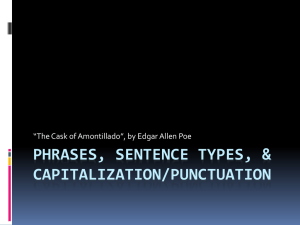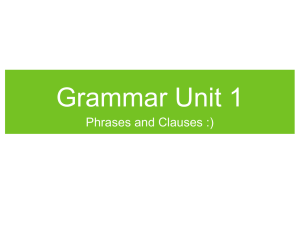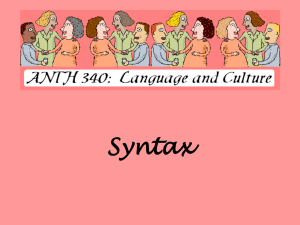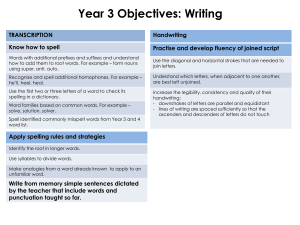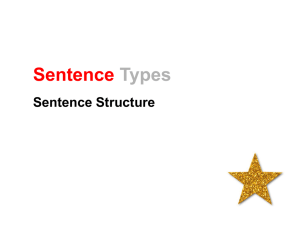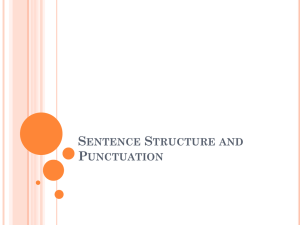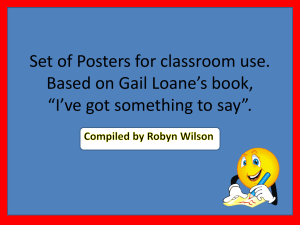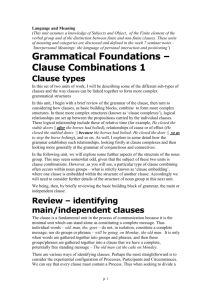Teaching Grammar for Writing
advertisement
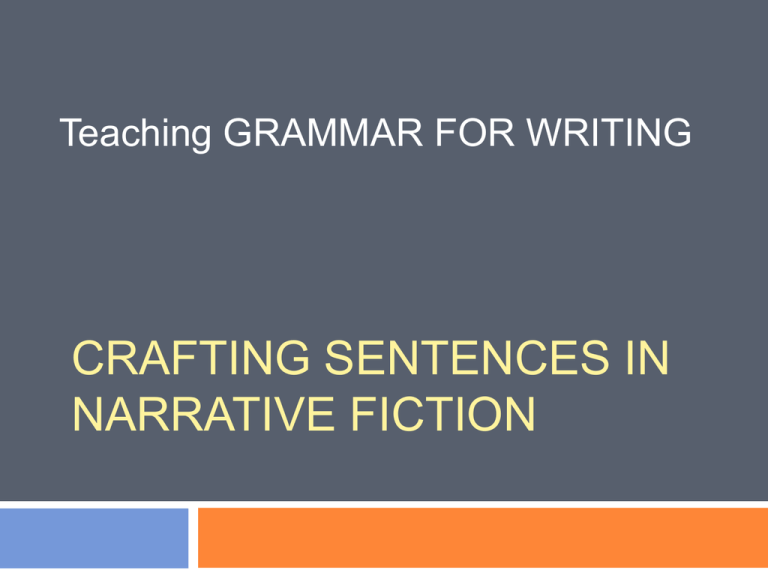
Teaching GRAMMAR FOR WRITING CRAFTING SENTENCES IN NARRATIVE FICTION Word class? cold ‘This is the third cold I’ve had this winter.’ striking ‘That’s a very striking coat you’re wearing.’ escape ‘Any attempt at escape is useless.’ wind ‘You really know how to wind me up!’ swirl ‘Finish with a swirl of cream.’ Word classes in context It was a bright cold day in April, and the clocks were striking thirteen. Winston Smith, his chin nuzzled into his breast in an effort to escape the vile wind, slipped quickly through the glass doors of Victory Mansions, though not quickly enough to prevent a swirl of gritty dust from entering along with him. Nineteen Eighty Four, George Orwell Aims To explore ways of teaching students about sentence construction and sentence variation To consolidate teachers’ subject knowledge about sentences To plan for teaching sentence variety in the context of narrative fiction Grammar is what gives sense to language… Sentences make words yield up their meanings. Sentences actively create sense in language and the business of the study of sentences is the study of grammar. David Crystal, Rediscover Grammar Conscious manipulation of syntax deepens engagement and releases invention. Ted Hughes Some basics What is the difference between a phrase, a clause and a sentence? Finite Verbs Necessary to create a main clause and therefore a sentence. They are inflected for person, number and tense (so changing the tense of a passage is an easy way to find most of them). Modal verbs are also finite (would, could, may etc). Imperatives are finite (Stay! Sit! Eat!). In a string of verbs, the first verb is the finite one. Find the finite verbs… It was a bright cold day in April, and the clocks were striking thirteen. Winston Smith, his chin nuzzled into his breast in an effort to escape the vile wind, slipped quickly through the glass doors of Victory Mansions, though not quickly enough to prevent a swirl of gritty dust from entering along with him. Nineteen Eighty Four, George Orwell The Sentence Simple sentence one clause containing a finite verb (main clause) Compound sentence two or more coordinated main clauses Complex sentence one main clause and one or more subordinate clauses Simple sentence One clause containing a finite verb. A simple sentence can be any length. The detective hurried along the street. The detective hurried along the rain-swept streets, his hands deep in his pockets. With his hands deep in his pockets one cold November night, the detective from New York hurried anxiously along the half-deserted, rain-swept streets, a troubled frown on his face. Identify the simple sentences I was just pushing the lower half of the ladder back up when I heard it. There was someone at the front door. I held my breath. It was OK. They couldn’t get in. I slid my hand into my pocket to make sure the key was still there. It wasn’t. I’d left it in the front door. I could hear it turning in the lock now. I raced back up the ladder and hauled it after me. When I reached down to pull the hatch back up, I could hear someone coming up the stairs. I quickly pulled the hatch back into place and scrabbled over to the water tank, holding my breath. (From Millions by Frank Cottrell Boyce) Can you add more detail to this sentence so that we have a clearer picture of the setting, characters and events? Use only one verb. • Choose more interesting nouns A boy and his dog sat in the The house was near a road. road. (e.g. teenager, pavement) • Choose a more interesting verb (e.g. crouched, were curled up) • Add more information to the verb with an adverb (e.g. despairingly, together) • Add more information to the noun with an adjective (e.g. hungry, exhausted) • Add more information with an adverbial phrase that tells you where, when or how something happens (e.g. outside the supermarket, on a cold winter’s day, in despair) • Change the order of words for emphasis (e.g. by moving the adverb to the start of the sentence) Coordination and…but...or words: phrases: clauses: words: phrases: clauses: words: phrases: clauses: bread and butter all the king’s horses and all the king’s men It’s getting late and I’m tired. tired but happy out of sight but not out of mind I like coffee but love tea. heads or tails table d’hôte or à la carte We can eat in or we can go out. Compound sentence It was a bright cold day in April, and the clocks were striking thirteen. She was startled and looked at her son. She looked at her son and was startled. Coordinating conjunctions: and, but, or BOYFANS but, or, yet, for, and, neither, so Sentence variety Some findings from research: Weaker writers tend to chain together finite clauses, (most frequently joined with and or by comma splicing). Stronger writers use a wider range of non-finite clauses to add detail, create mood and rhythm. However, stronger writers also use simple sentences for effect. (QCA, 1999; Myhill, 2001) Subordination Subordinating conjunctions join a dependent or subordinate clause to a main clause to create a complex sentence e.g. after, although, as, as if, as long as, before, if, in case, since, unless, while, when(ever), where(ever), whereas, because Make up a subordinate clause to precede the following main clause: We didn’t wear our coats How many different ways can you join the main clauses to the subordinate clauses? Which sentences sound the scariest? slowly decaying the house seemed empty its windows boarded up covered with ivy smiling holding a flickering candle beckoning me to follow her a woman stood in the doorway Complex sentence A subordinate clause is formed from: A subordinating conjunction + finite verb As she slid down towards the edge.... .....when I heard it. A relative pronoun + finite verb Winston, who was thirty-nine.... A non-finite verb (present/past participles; the infinitive) Holding my breath.... Trapped in the attic.... To make sure the key was still there.... Sentence combining The boy bit his lip. He kept back the tears. He advanced. The man raised his arm. Combine: to make compound sentences to make one complex sentence The boy, biting his lower lip so as to keep back the tears, advanced, and the man raised his arm. From The Breadwinner, Lesley Halward Identify subordinate clauses That was when Iorek moved. Like a wave that has been building its strength over a thousand miles of ocean, and which makes little stir in the deep water, but which when it reaches the shallows rears itself up high into the sky, terrifying the shore-dwellers, before crashing down on the land with irresistible power – so Iorek Byrnison rose up against Iofur, exploding upwards from his firm footing on the dry rock and slashing with a ferocious left hand at the exposed jaw of Iofur Raknison. It was a horrifying blow. It tore the lower part of his jaw clean off, so that it flew through the air scattering blood-drops in the snow many yards away. (Description of the bear fight in Northern Lights by Philip Pullman) How did Philip Pullman do that? Iorek Byrnison rose up against Iofur Like a wave that has been building its strength over a thousand miles of ocean, Iorek Byrnison rose up against Iofur Like a wave that has been building its strength over a thousand miles of ocean, and which makes little stir in the deep water, but which when it reaches the shallows rears itself up high into the sky, terrifying the shore-dwellers, before crashing down on the land with irresistible power – so Iorek Byrnison rose up against Iofur, exploding upwards from his firm footing on the dry rock and slashing with a ferocious left hand at the exposed jaw of Iofur Raknison. ‘Conscious control for effect’ And it seemed to happen so slowly, but there was nothing she could do: her weight shifted, the stones moved under her feet, and helplessly she began to slide. In the first moment it was annoying, and then it was comic: she thought how silly! But as she utterly failed to hold on to anything, as the stones rolled and tumbled beneath her, as she slid down towards the edge, gathering speed, the horror of it slammed into her. She was going to fall. There was nothing to stop her. It was already too late. The Amber Spyglass, Philip Pullman Putting verbs in their place… A squat grey building of only thirty-four storeys. Over the main entrance the words, CENTRAL LONDON HATCHERY AND CONDITIONING CENTRE, and, in a shield, the World State's motto, COMMUNITY, IDENTITY, STABILITY. Aldous Huxley, Brave New World What the Dickens? LONDON. Michaelmas Term lately over, and the Lord Chancellor sitting in Lincoln’s Inn Hall. Implacable November weather. As much mud in the streets as if the waters had but newly retired from the face of the earth, and it would not be wonderful to meet a Megalosaurus, forty feet long or so, waddling like an elephantine lizard up Holborn Hill. Smoke lowering down from chimney-pots, making a soft black drizzle, with flakes of soot in it as big as fullgrown snow-flakes — gone into mourning, one might imagine, for the death of the sun. Dogs, undistinguishable in mire. Horses, scarcely better; splashed to their very blinkers. Foot passengers, jostling one another’s umbrellas in a general infection of ill-temper, and losing their foot-hold at street-corners, where tens of thousands of other foot passengers have been slipping and sliding since the day broke (if the day ever broke), adding new deposits to the crust upon crust of mud, sticking at those points tenaciously to the pavement, and accumulating at compound interest. “I believe the road to hell is paved with adverbs” - Stephen King On Writing Create a word bank of verbs to describe this picture. Write a short paragraph using your verbs effectively. Phrases I lived alone for a long time in the house at the end of the street. Noun phrase: the house at the end of the street Verb phrase: I lived alone Prepositional phrases: in the house; at the end of the street Adjectival phrase: the house at the end of the street Adverbial phrase: I lived alone for a long time in the house at the end of the street Aaagh! Beam me up! Don’t panic! Descriptions of grammar or syntax operate on many levels concurrently. e.g. A group of words can be a finite subordinate clause and also an adverbial clause at the same time. e.g. A prepositional phrase can also be an adjectival phrase. e.g. A subordinating connective (who) can also be a relative pronoun. This is not a cause to despair. You don’t need to know everything! Concentrate on a few specific points to help students’ writing. Agree them with each other – and what to call them. Teaching adverbials Generic term for words/phrases/clauses that add detail of when, where and how something happens: Time ‘I walked in the dusky evening.’ Place ‘I walked through the shadowy forest.’ Manner ‘I walked on, feeling afraid’ Teaching Adverbials Create atmosphere (melodrama, foreboding, melancholy). Change verbs, add adverbials (words, phrases or clauses). I walked through the city. The sun shone. Wispy clouds moved across the sky. People crowded the streets. Still, I was alone. The power of punctuation The way a sentence is punctuated communicates the relative importance and relevance of points and can create or solve ambiguities for the reader. How many different ways can you punctuate the following: A woman without her man is nothing Teaching punctuation Punctuation is about awareness of grammatical chunks to split up texts into sentences indicating clearly where each major chunk of meaning begins and ends we use capital letters and full stops within the sentence we use a variety of punctuation marks to show breaks between phrases clauses and sometimes words Teaching punctuation Punctuation is about awareness of grammatical chunks. To split up texts into sentences, indicating clearly where each major chunk of meaning begins and ends, we use capital letters and full stops. Within the sentence, we use a variety of punctuation marks to show breaks between phrases, clauses and, sometimes, words. Punctuate for meaning Speakers use tone of voice to shape meaning. Writers use punctuation marks. David Crystal It’s not there. It’s not there! It’s not there? Writers’ choices I listened and at last I heard it a tiny squeaking sound far off like it was coming from another world. I listened, and at last I heard it: a tiny squeaking sound, far off, like it was coming from another world. Writers’ choices Black shapes were emerging out of thin air all around them blocking their way left and right eyes glinted through slits in hoods a dozen lit wand tips were pointing directly at their hearts Ginny gave a gasp of horror Harry Potter and the Order of the Phoenix, Chapter 35 Black shapes were emerging out of thin air all around them, blocking their way left and right; eyes glinted through slits in hoods, a dozen lit wand tips were pointing directly at their hearts; Ginny gave a gasp of horror. Using commas We use commas: before but in a compound sentence to separate the subordinate clause from the main clause when the subordinate clause comes first after a connective that links across or between sentences to separate items in a list round additional information in a sentence that can be removed without affecting meaning. Writing conversations Talking about patterns and features of language helps pupils to become more aware of them and so to use them better as tools for thinking and expression. Rhetorical grammar rules Linked to students’ own reading and writing, not studied separately. Teaching features and patterns of language and how they create meaning or effects. Detailed and explicit discussion about language in context using real examples, not simplistic descriptions such as “adjectives create good description” “short sentences create impact”. Not focused on accuracy. Always support technical terminology with examples. Final Recap ‘Grammar,’ as a word, has many shades of meaning. When it comes to attempts to describe language, there are many different ‘grammars’. Language came first: grammar is just an attempt to describe it! You already have expert implicit knowledge about language. When teaching, remember to focus on language in context and on how any features you teach can be used in students’ own writing. Have fun!
